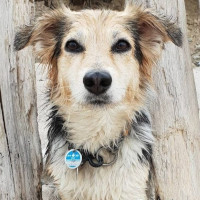Appearance of the Shethund
|
| Your hybrid Shethund is a mix of Shetland Sheepdog and Dachshund and, as such, may inherit appearance traits from one or both parent breeds. Shethund breeders and owners describe him as weighing between 4.5 and 8 kilos at full maturity and having the body, coat and muzzle of the Sheltie and the short little legs of the Dachshund parent. In addition, depending on which of the breed's parents has the most influence in the biological mix, its coat colors may be brown, tan, red, sable, blue merle and white, its coat may be double with a long, straight topcoat and a short, downy undercoat, or it may be smooth or harsh, long or short, dark, almond-shaped eyes with blue eyes possible if her color is blue merle, a black nose and high-set ears that are either long and soft and hanging, or smaller and straight with tips breaking forward. She will probably have a longer tail, but not curled or arched over her back. |
Temperament of the Shethund
|
| Your hybrid Shethund is a mix of Shetland Sheepdog and Dachshund and can inherit temperament and personality traits from either or both of the parent breeds. The traits it can inherit are kindness, affection, aggression, courage, gentleness and intelligence. They are also known to be independent, social, loving, lively, loyal, playful and reactive. He has a high level of sensitivity and can be a frequent barker. He's well suited to new owners, but if you have children, be aware that he'll need proper socialization from an early age to be more sure of getting along with younger people who may not know how to play with and touch him. He'll probably get on well with the family cat, but don't forget that he has a strong urge to hunt. This could lead him to try to herd small animals and even children because of his deep hunting and herding instincts. He also has a strong tendency to wander, another instinct deeply rooted in his heritage. He's likely to get along with strangers, although he may be wary at first, but will warm to them once he feels they pose no danger to his human family. The Dachshund parent brings a certain independence, but for the most part, he should be relatively easy to train, as he has a strong desire to please those he loves. They have a great deal of energy, which needs to be managed on a daily basis to keep everyone in the household happy. |
Needs and activities of the Shethund
|
| Your Shethund Hybrid is an active dog, requiring daily exercise periods of at least 1 to 2 hours a day. This exercise can take the form of several daily walks or jogs, play in a dog park or fenced yard, interactive games such as fetch, Frisbee or flyball, agility or obedience training. He's classified as a hunter and a wanderer, so you'll need to keep him on a leash when he's away from the house, fenced yard or other safe area. If you ignore this recommendation, you'll probably find yourself getting more exercise than you bargained for by chasing him down the street, through the neighborhood or into the woods in search of a small animal or an interesting scent that has caught his eye. He's small enough to cope with an apartment or condominium, as long as noise restrictions are taken into account and appropriate daily exercise opportunities are provided. It can also get along very well in a family home with or without a fenced yard, with appropriate exercise opportunities, in a rural or urban environment. He is best suited to a temperate climate, provided he has adequate protection and appropriate precautions for extreme temperatures, hot or cold. |
Maintenance of the Shethund
|
| Your Shethund Hybrid falls into the moderate maintenance and shedding category. His coat is not considered hypoallergenic. Brushing frequency depends on the dominant breed in the biological mix, with smooth coats brushed once a week and longer, thicker coats brushed daily, especially during heavy shedding seasons. He's in the low category for drool and odor. He barks frequently, which should be taken into account for people living in noise-restricted areas. He's in the moderate category for urge to hunt and tendency to wander, which is why it's important to keep him on a leash when he's outside the house, a fenced yard or other safe enclosure. This is an active dog that will need 1-2 hours of daily exercise to stay fit, healthy and happy. His ears should be checked weekly and cleaned if necessary with a cotton ball and a dog-approved ear cleaner. Be sure to check his nails weekly, trimming them if necessary, unless he's able to keep them worn during normal exercise activities. Brush his teeth two or three times a week to prevent the development of periodontal disease and the tooth loss that can accompany it. |









 English (United Kingdom)
English (United Kingdom)